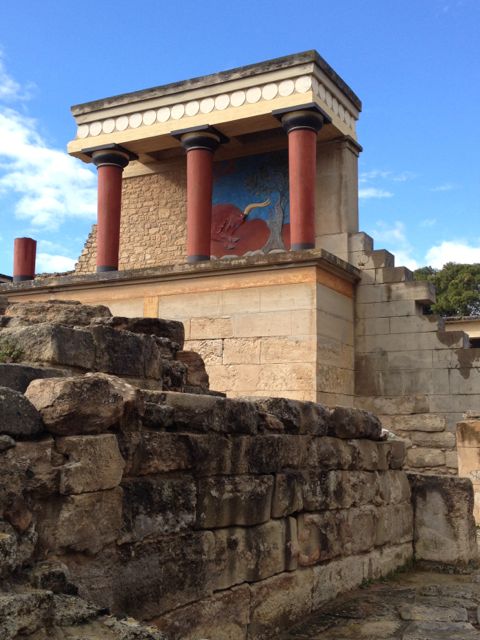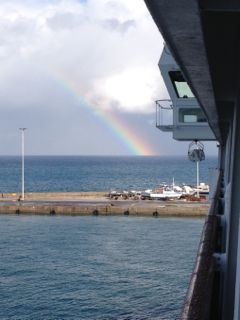For a while, I thought our stay in Greece would have to forego sightseeing. The day before we arrived in Athens, I bit down on something that my capped front tooth found immovable. One of those new-fangled caps that get built up in the dentist’s office on some fancy laser machine—it simply shattered and gave me quite the hillbilly grin. So when we arrived in Athens, I spent much of the day at a local dentist being fitted with a temporary cap. (Let’s hope this one lasts another eighty days!).
 While Robert and I missed Athens, our next day in the Cretan port of Heraklion and a visit to the nearby ancient palace of Knossos was truly memorable. For those who might not know their ancient Mediterranean civilizations, the Minoan culture was centered here long before the rise of the Greeks. They appeared to have been a prosperous and peaceful population of traders who understood the value of running water and flushing toilets. Unfortunately for them, a massive volcano eruption some 3400 hundred years ago (the one that created the incredible caldera harbor in Santorini) resulted in earthquakes, tsunami, and fire that pretty much leveled their main center called Knossos. Their massive dark storerooms of olive oil were only lit by lamps, so when the earthquake dropped those open flames into the oil, the fire raced through the complex built with a heavy use of wooden beams for structural support. Everything collapsed. The alabaster walls are still darkened from the flames.
While Robert and I missed Athens, our next day in the Cretan port of Heraklion and a visit to the nearby ancient palace of Knossos was truly memorable. For those who might not know their ancient Mediterranean civilizations, the Minoan culture was centered here long before the rise of the Greeks. They appeared to have been a prosperous and peaceful population of traders who understood the value of running water and flushing toilets. Unfortunately for them, a massive volcano eruption some 3400 hundred years ago (the one that created the incredible caldera harbor in Santorini) resulted in earthquakes, tsunami, and fire that pretty much leveled their main center called Knossos. Their massive dark storerooms of olive oil were only lit by lamps, so when the earthquake dropped those open flames into the oil, the fire raced through the complex built with a heavy use of wooden beams for structural support. Everything collapsed. The alabaster walls are still darkened from the flames.
If you know anything of Knossos and the Minoan world, it’s probably the legend of the fearsome Minotaur (half man, half bull) that lived in the labyrinth beneath the palace and was fed seven young men and seven young women from Greece on a regular basis. According to myth, King Minos was given a massive bull that was supposed to have been sacrificed to the gods, but the King thought it was too beautiful to kill. The vengeful gods made Minos’s wife fall in love and mate with the beast resulting in a man-hungry monster. Oh, those Greek gods. There are many remaining frescos that play homage to the way Minoans worshipped bulls.
Back to the palace. Its excavation began in the early 1900s, and the man who funded it had no qualms about rebuilding portions of the ruins with modern concrete. While archeologists today tut about that, there is something cool in wandering around this massive building and encountering the occasional reconstructed wall or pillar. It lets you imagine how the complex might once have appeared, which foundation walls alone would never have inspired.
In a way, I feel I have been here before. Back in the late sixties, my sister lived in Heraklion when her husband was stationed here for the Air Force. This former brother-in-law was both an ardent photographer and lecturer. When he and my sister returned to the States, he presented his Knossos talk to the family more than once. (Even to a Mercer (WI) High School history class as I recall!) In any case, despite his sometimes overzealous slide shows, I’ve long wanted to see Knossos for myself—and now I have.
If the walls could talk, I’m sure they would have many stories to tell. But since no one has yet been able to decipher the original Minoan writing (called Linear A), we will probably never know what exactly those stories are. Given the beautiful setting of the place and the general lack of fortifications, I’d like to think they were happy ones.
Robert adds: So we have another ancient civilization under our belts—the Minoans. And what a weather day we’ve had—40-degree morning, overcast skies, light sprinkles of rain, followed by heavy downpour, and then even a brief period of hail! Fortunately, we were under cover for that last bit. Returning to the ship at the end of the tour, we could see an incredible rainbow over the sea, and snow on the 8,000-foot mountain peak of Crete. Beautiful.
But speaking of ancient peoples, I wanted to also acknowledge a comment my Uncle Robin made a few days ago. When we left Gibraltar, he reminded me that recent DNA genetic tracing revealed that remnants of the last known tribes of Neanderthal man lived in the Gibraltar area as recently (in geologic time) as 30,000 years ago. I would hasten to add that I think there might be a few holdouts here among the passengers of the Rotterdam. They haven’t consented to inner cheek swabs, but I base it on circumstantial evidence that is almost too strong to ignore and I now present for you—“Tales of the Oblivious.”
Long-standing shipboard tradition of “walking the promenade” has been to process in a counterclockwise fashion in the direction of travel. In other words, starting from the front, one walks to the back of the ship on the left (port) side, and then continues from back to front on the starboard side. On our earliest cruises in the mid-80s, the ships had directional signs—“Walk This Direction”—with an arrow pointing in the proper way. Even though these signs are no more, most people seem to know the correct way to promenade. But, what about the one or two people walking against the stream? We see them on every cruise, and I have to think, “Don’t they notice that they’re going completely opposite everyone else?” Do they not wonder, “Why is everybody going in the other direction?” And the thing is, there are times when there are lots and lots of people walking, and these USP—the “upstream salmon people”—really do stick out like a sore thumb. So, are they just oblivious, meandering in blissful ignorance? Or is it even worse, recognizing the opposite flow and just not caring? I can’t decide which is worse.
Meanwhile, we are enjoying reading comments that people leave here, so keep ’em coming.
To check out Dennis’s novels, visit www.amazon.com/author/dennisfrahmann